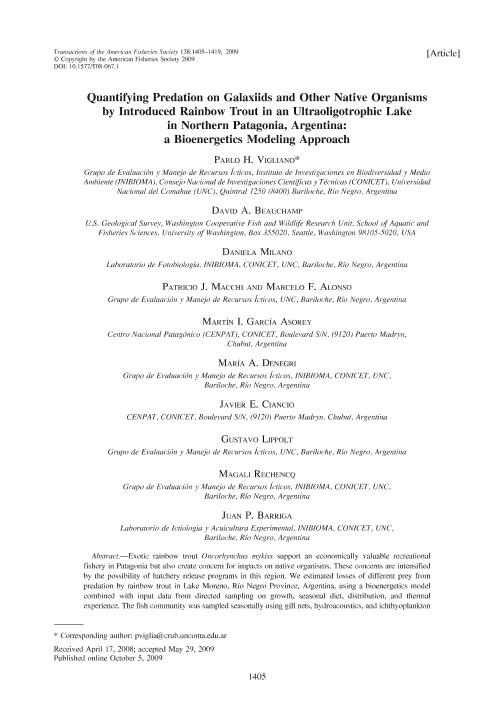Mostrar el registro sencillo del ítem
dc.contributor.author
Vigliano, Pablo Horacio

dc.contributor.author
Beauchamp, David

dc.contributor.author
Milano, Daniela

dc.contributor.author
Macchi, Patricio Jorge

dc.contributor.author
Alonso, Marcelo Fabián

dc.contributor.author
Garcia Asorey, Martin Ignacio

dc.contributor.author
Denegri, Maria Amalia

dc.contributor.author
Ciancio Blanc, Javier Ernesto

dc.contributor.author
Lippolt, Gustavo
dc.contributor.author
Rechencq, Magali

dc.contributor.author
Barriga, Juan Pablo

dc.date.available
2020-01-22T19:45:54Z
dc.date.issued
2009-05
dc.identifier.citation
Vigliano, Pablo Horacio; Beauchamp, David; Milano, Daniela; Macchi, Patricio Jorge; Alonso, Marcelo Fabián; et al.; Quantifying predation on galaxiids and other native organisms by introduced rainbow trout in an ultraoligotrophic lake in northern Patagonia, Argentina: A bioenergetics modeling approach; American Fisheries Society; Transactions Of The American Fisheries Society; 138; 6; 5-2009; 1405-1419
dc.identifier.issn
0002-8487
dc.identifier.uri
http://hdl.handle.net/11336/95615
dc.description.abstract
Exotic rainbow trout Oncorhynchus mykiss support an economically valuable recreational fishery in Patagonia but also create concern for impacts on native organisms. These concerns are intensified by the possibility of hatchery release programs in this region. We estimated losses of different prey from predation by rainbow trout in Lake Moreno, Río Negro Province, Argentina, using a bioenergetics model combined with input data from directed sampling on growth, seasonal diet, distribution, and thermal experience. The fish community was sampled seasonally using gill nets, hydroacoustics, and ichthyoplankton nets. Pelagic galaxiid larvae and benthic juvenile and adult small puyen Galaxias maculatus were the most important components of the diet. Bioenergetics simulations showed that over a 6-year life span in the lake (ages 1-7), rainbow trout attained a body mass of 2.3 kg and consumed 74.7 kg of food, of which 20% consisted of galaxiid larvae and 16% consisted of adult small puyen. Based on an estimated abundance of 29,000 rainbow trout of ages 1-7, this predator exerted significant but sustainable mortality on the native prey populations, consuming 44 metric tons or an estimated 23% of the annual larval galaxiid production and 35 metric tons of adult small puyen, which represented an unknown fraction of the postlarval population. Galaxiids supported the estimated predation demand under current conditions. However, simulations of stocking strategies normally proposed for this region showed that consumption demands on prey would increase to unsustainable levels, reducing native fish populations and likely reducing growth of rainbow trout. It is also probable that the fish community composition would shift further in response to the increased demand for prey by stocked predators. This implies that in some cases, stocking could jeopardize sport fisheries; stocking strategies should be evaluated on a case-by-case basis to be consistent with specific objectives for native fish conservation and sustainable food web interactions.
dc.format
application/pdf
dc.language.iso
eng
dc.publisher
American Fisheries Society

dc.rights
info:eu-repo/semantics/openAccess
dc.rights.uri
https://creativecommons.org/licenses/by-nc-sa/2.5/ar/
dc.subject
salmonid introduced
dc.subject
galaxiids
dc.subject
predation
dc.subject
bioenergetic
dc.subject.classification
Ecología

dc.subject.classification
Ciencias Biológicas

dc.subject.classification
CIENCIAS NATURALES Y EXACTAS

dc.title
Quantifying predation on galaxiids and other native organisms by introduced rainbow trout in an ultraoligotrophic lake in northern Patagonia, Argentina: A bioenergetics modeling approach
dc.type
info:eu-repo/semantics/article
dc.type
info:ar-repo/semantics/artículo
dc.type
info:eu-repo/semantics/publishedVersion
dc.date.updated
2019-12-12T14:48:04Z
dc.journal.volume
138
dc.journal.number
6
dc.journal.pagination
1405-1419
dc.journal.pais
Estados Unidos

dc.description.fil
Fil: Vigliano, Pablo Horacio. Consejo Nacional de Investigaciones Científicas y Técnicas. Centro Científico Tecnológico Conicet - Patagonia Norte. Instituto de Investigaciones en Biodiversidad y Medioambiente. Universidad Nacional del Comahue. Centro Regional Universidad Bariloche. Instituto de Investigaciones en Biodiversidad y Medioambiente; Argentina
dc.description.fil
Fil: Beauchamp, David. University of Washington; Estados Unidos
dc.description.fil
Fil: Milano, Daniela. Consejo Nacional de Investigaciones Científicas y Técnicas. Centro Científico Tecnológico Conicet - Patagonia Norte. Instituto de Investigaciones en Biodiversidad y Medioambiente. Universidad Nacional del Comahue. Centro Regional Universidad Bariloche. Instituto de Investigaciones en Biodiversidad y Medioambiente; Argentina
dc.description.fil
Fil: Macchi, Patricio Jorge. Universidad Nacional del Comahue. Centro Regional Universitario Bariloche. Grupo de Evaluación y Manejo de Recursos Ícticos; Argentina
dc.description.fil
Fil: Alonso, Marcelo Fabián. Universidad Nacional del Comahue. Centro Regional Universitario Bariloche. Grupo de Evaluación y Manejo de Recursos Ícticos; Argentina
dc.description.fil
Fil: Garcia Asorey, Martin Ignacio. Consejo Nacional de Investigaciones Científicas y Técnicas. Centro Científico Tecnológico Conicet - Centro Nacional Patagónico; Argentina
dc.description.fil
Fil: Denegri, Maria Amalia. Consejo Nacional de Investigaciones Científicas y Técnicas. Centro Científico Tecnológico Conicet - Patagonia Norte. Instituto de Investigaciones en Biodiversidad y Medioambiente. Universidad Nacional del Comahue. Centro Regional Universidad Bariloche. Instituto de Investigaciones en Biodiversidad y Medioambiente; Argentina
dc.description.fil
Fil: Ciancio Blanc, Javier Ernesto. Consejo Nacional de Investigaciones Científicas y Técnicas. Centro Científico Tecnológico Conicet - Centro Nacional Patagónico; Argentina
dc.description.fil
Fil: Lippolt, Gustavo. Universidad Nacional del Comahue. Centro Regional Universitario Bariloche. Grupo de Evaluación y Manejo de Recursos Ícticos; Argentina
dc.description.fil
Fil: Rechencq, Magali. Consejo Nacional de Investigaciones Científicas y Técnicas. Centro Científico Tecnológico Conicet - Patagonia Norte. Instituto de Investigaciones en Biodiversidad y Medioambiente. Universidad Nacional del Comahue. Centro Regional Universidad Bariloche. Instituto de Investigaciones en Biodiversidad y Medioambiente; Argentina. Universidad Nacional del Comahue. Centro Regional Universitario Bariloche. Grupo de Evaluación y Manejo de Recursos Ícticos; Argentina
dc.description.fil
Fil: Barriga, Juan Pablo. Consejo Nacional de Investigaciones Científicas y Técnicas. Centro Científico Tecnológico Conicet - Patagonia Norte. Instituto de Investigaciones en Biodiversidad y Medioambiente. Universidad Nacional del Comahue. Centro Regional Universidad Bariloche. Instituto de Investigaciones en Biodiversidad y Medioambiente; Argentina
dc.journal.title
Transactions Of The American Fisheries Society

dc.relation.alternativeid
info:eu-repo/semantics/altIdentifier/url/https://afspubs.onlinelibrary.wiley.com/doi/abs/10.1577/T08-067.1
dc.relation.alternativeid
info:eu-repo/semantics/altIdentifier/doi/http://dx.doi.org/10.1577/T08-067.1
Archivos asociados
